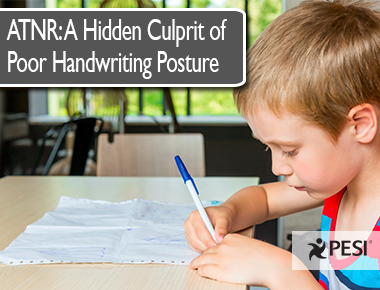A Hidden Culprit of Poor Handwriting Posture

We know that good posture is important to ensure stress on your muscles, joints and ligaments is distributed evenly across your body. Proper posture when writing is especially important, so it's no wonder we spend so much time teaching our children what proper handwriting posture looks like:
In the video below, Kathy Johnson, MS Ed., explores what happens to handwriting when the Asymmetrical Tonic Neck Reflex (ATNR) is retained.
This blog was brought to life by PESI speaker Kathy Johnson, MS Ed. Johnson is the author of The Roadmap From Learning Disabilities To Success, a nationally recognized expert in multiple therapy methods including: Primitive Reflex Training, Therapeutic Listening, Samonas Listening, PACE, Phono-Graphix, Irlen Syndrome, Brain Gym 101, and An Introduction to Rhythmic Movement.
- Feet flat on the floor
- Thighs parallel to floor and knees at a 90 degree angle
- Back up straight, inclined towards the desk and pivoted from the hips
- Forearms resting on desk with elbows level with the desktop at 90 degrees
- Paper stabilized with non-dominant hand
- Neck and shoulders relaxed
- Body faces desk squarely so non-dominant arm can support body weight
- Paper tilted to the up to the right (if right handed) or up to the (if left handed)
In the video below, Kathy Johnson, MS Ed., explores what happens to handwriting when the Asymmetrical Tonic Neck Reflex (ATNR) is retained.
This blog was brought to life by PESI speaker Kathy Johnson, MS Ed. Johnson is the author of The Roadmap From Learning Disabilities To Success, a nationally recognized expert in multiple therapy methods including: Primitive Reflex Training, Therapeutic Listening, Samonas Listening, PACE, Phono-Graphix, Irlen Syndrome, Brain Gym 101, and An Introduction to Rhythmic Movement.
Topic: Learning Disabilities
Tags: Asymmetrical Tonic Neck Reflex (ATNR)


